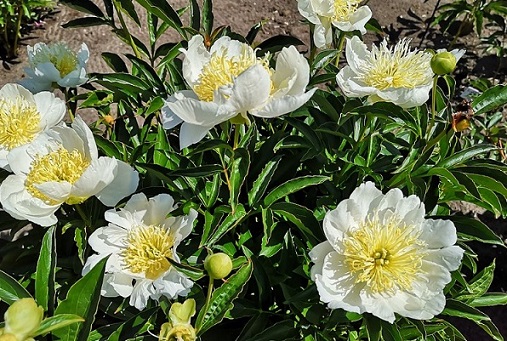Phytochemical from Chinese Herb Shows Potential in Stroke Treatment Through Estrogen Receptor Pathway
Nikhil Prasad Fact checked by:Thailand Medical News Team Jul 12, 2025 5 months, 3 weeks, 2 days, 2 hours, 39 minutes ago
Thailand Medical News: Traditional Chinese Herb Extract Paeoniflorin Identified as a Promising Stroke Therapy
A team of researchers from Hong Kong Baptist University, Nanfang Hospital at Southern Medical University in Guangzhou, Lanzhou University, and The Education University of Hong Kong has made a significant breakthrough in stroke research. Their work highlights how a phytochemical compound called paeoniflorin (PF), derived from traditional Chinese herbs, could offer a new avenue for stroke treatment by targeting a specific protein in the brain known as ESR1 (Estrogen Receptor 1).
 The root of the White Peony is a rich source of the phytochemical Paeoniflorin
The root of the White Peony is a rich source of the phytochemical Paeoniflorin
Paeoniflorin is primarily found in the root of the Chinese herb Paeonia lactiflora Pall., commonly known as White Peony or Chinese Peony. This herb has been used in traditional Chinese medicine for centuries
According to this
Thailand Medical News report, the study combined large-scale data mining, bioinformatics, and laboratory validation to explore how traditional remedies might support modern stroke therapy. Stroke remains one of the leading causes of death and disability worldwide, affecting nearly 94 million people and incurring economic losses of over $890 billion annually. However, current medications for stroke are limited and often come with side effects or strict timing for effectiveness. That’s why researchers are increasingly turning to traditional medicines in search of safer, multi-targeted options.
Finding the Key Players in Traditional Herbal Medicine
The researchers analyzed over 50 traditional Chinese medicine (TCM) formulas used for stroke treatment and narrowed down the most frequently used herbs. Seven herbs emerged as central: Angelicae Sinensis Radix, Pheretima, Chuanxiong Rhizoma, Persicae Semen, Astragali Radix, Carthami Flos, and Radix Paeoniae Rubra. These herbs were found to contain hundreds of active compounds with potential to influence over 190 genes linked to stroke.
Among the compounds, paeoniflorin stood out. It was found to have a strong and specific interaction with the ESR1 protein. This protein plays a key role in protecting neurons during brain injury caused by stroke. Molecular docking simulations showed that paeoniflorin binds to ESR1 with a high affinity, a critical indicator of therapeutic potential.
Paeoniflorin Protects Brain Cells in the Lab
To confirm the results from computational analysis, researchers conducted laboratory experiments on HT22 brain cells. These cells were subjected to oxygen-glucose deprivation—a model that mimics the effects of stroke. The results were clear: Paeoniflorin treatment significantly improved cell survival and boosted the expression of ESR1 in damaged cells. In simple terms, PF helped protect brain cells from dying due to stroke-like conditions.
Moreover, paeoniflorin was shown to be safe at various doses and didn’t harm healthy cells, further enhancing its profile as a potential treatment. Its dual action&am
p;mdash;improving cell viability and boosting a protective brain receptor—demonstrates its powerful therapeutic capabilities.
The Bigger Picture of Paeoniflorin’s Role
While PF’s impact on ESR1 is central, the study also noted that it interacts with other important proteins involved in cell survival and inflammation, such as CASP3, PTGS2, and PPARG. These interactions suggest that paeoniflorin works on multiple levels to protect the brain—a key advantage of TCM compounds, which are known for their holistic effects.
The research team also emphasized the importance of their new research method called Data-Mining-Derived Approach (DMDA). This strategy combines data from real-world clinical use of TCM with advanced lab testing and artificial intelligence, making it easier to identify promising compounds like paeoniflorin from the sea of traditional remedies.
Conclusion
This research not only shines a spotlight on the potential of traditional Chinese medicine in treating modern health crises like stroke but also offers a new path forward for developing safe, effective, and multi-targeted therapies. By focusing on paeoniflorin and its effects on ESR1, the study lays the foundation for a new class of drugs that may one day protect millions from the devastating effects of stroke. With further research and clinical trials, this herbal compound could become a valuable weapon in the global fight against stroke-related brain damage.
The study findings were published in the peer reviewed journal: Pharmaceuticals
https://www.mdpi.com/1424-8247/18/7/933
For the latest on stroke treatments, keep on logging to
Thailand Medical News.
Read Also:
https://www.thailandmedical.news/news/lactate-may-hold-the-key-to-preventing-brain-cell-death-in-stroke-victims
https://www.thailandmedical.news/news/stem-cell-derived-vesicles-as-a-new-hope-for-stroke-recovery
https://www.thailandmedical.news/news/folic-acid-supplementation-can-reduce-risk-of-stroke-by-22-percent
